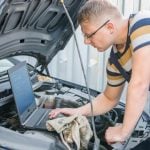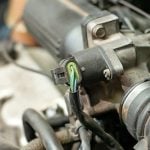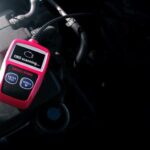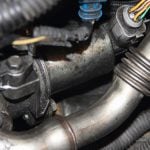If you see your ‘Check Engine’ light on and can smell fuel vapors coming from your car, you could have a P1456 engine trouble code. Here’s how to fix it!
Any engine trouble code that starts with P1XXX is a manufacturer-specific code – it can mean different things for different models. The P1456 engine code is specific to Honda, Nissan, and a few other vehicle models. It indicates a fuel vapor leak or problem with purging it from the engine. Here’s a quick explainer with everything you need to know about it.
What does the P1456 trouble code mean?
The P1456 code indicates a problem with the Evaporative Emission Control System (EVAP Control System). The EVAP is responsible for collecting and temporarily storing fuel vapors from within the fuel tank to stop them from escaping into the atmosphere. The collected vapors are reinjected into the engine via the intake manifold, where they can be burned.
Whenever there is a fuel leak due to improper closing of the fuel cap or a malfunction in the purging system, a P1456 code will be recorded.
What are the symptoms of a P1456 code?
- Your ‘Check Engine’ light will be illuminated
- You may smell fuel vapors due to the leak
What causes a P1456 code?
While the broad problem that causes a P1456 code is a leak in the Evaporative Emissions Systems, you could further pinpoint the cause of the leak as one of the following:
- The fuel cap may be missing/ loosely screwed on
- You may have fitted the wrong fuel filler cap
- The fuel tank or filler neck might be damaged
- There might be something obstructing the fuel cap from being closed
- The fuel tank pressure sensor might be damaged
- There might be leaks in the tubes/hoses used in the EVAP system
- Damages in the carbon canister
Is it safe to drive with a P1456 code?
Yes, having a P1456 code will not affect the drivability or functionality of the car. You can continue driving the car in the short term until you get an opportunity to check the EVAP system and diagnose the problem.
How to diagnose a P1456 trouble code
To diagnose the P1456 error code, you need a good OBD-II (on-board diagnostics) scanning tool.
Allow the vehicle to cool down for around four hours before performing the leak test. This ensures that the engine is cool enough and acts as a baseline for testing the leak. It’s also best to fill the fuel tank between 15% and 85% of its capacity.
- To diagnose the trouble code, you should let the car complete at least one drive cycle. One drive cycle is the point from when the engine is stone cold until it reaches operating temperature.
- The vehicle’s Powertrain Control Module (PCM) will act to prevent any outside air from entering the EVAP system by closing the vent valves and activating the purge valves.
- The engine will pull a vacuum on the fuel tank while the PCM monitors it via the fuel tank pressure sensor.
- If there is a drop in vacuum during the test, the computer will sense that there is a fuel vapor leak. If the EVAP system cannot maintain the vacuum for two consecutive tests, it will lead to a P1456 error code which illuminates the ‘Check Engine’ light.
You can confirm the presence of the code by plugging your OBD-II scanner into the car’s DLC port and reading the error code.
How can you fix a P1456 error code?
- Carry out visual and physical inspections of the fuel tank and cap to ensure it is properly in place
- Ensure there are no obstructions on the filler neck
- Clean the cap of any foreign matter or debris
- Replace the fuel cap if you have misplaced it with another type
- Ensure there are no leakages, perforations, or holes in the EVAP system tubes.
Manually clear the code and let the vehicle perform at least two drive cycles. Ideally, the ‘Check Engine’ light should turn off after successfully passing them.
If the problem persists, your EVAP system might have further issues, which would require the attention of a trained technician.
How much will fixing a P1456 code cost?
Provided the problem is minor and does not involve replacing any major components of your EVAP system, fixing a P1456 code will cost less than $100. However, if you need to replace your vehicle’s EVAP system or canisters, you may have to shell out up to $600.
Renée Martin is a travel and car expert who focuses on road and air travel in the U.S. For the past 6 years, she’s been helping make driving and trip planning easier and budget-friendly for everyday travelers.



















